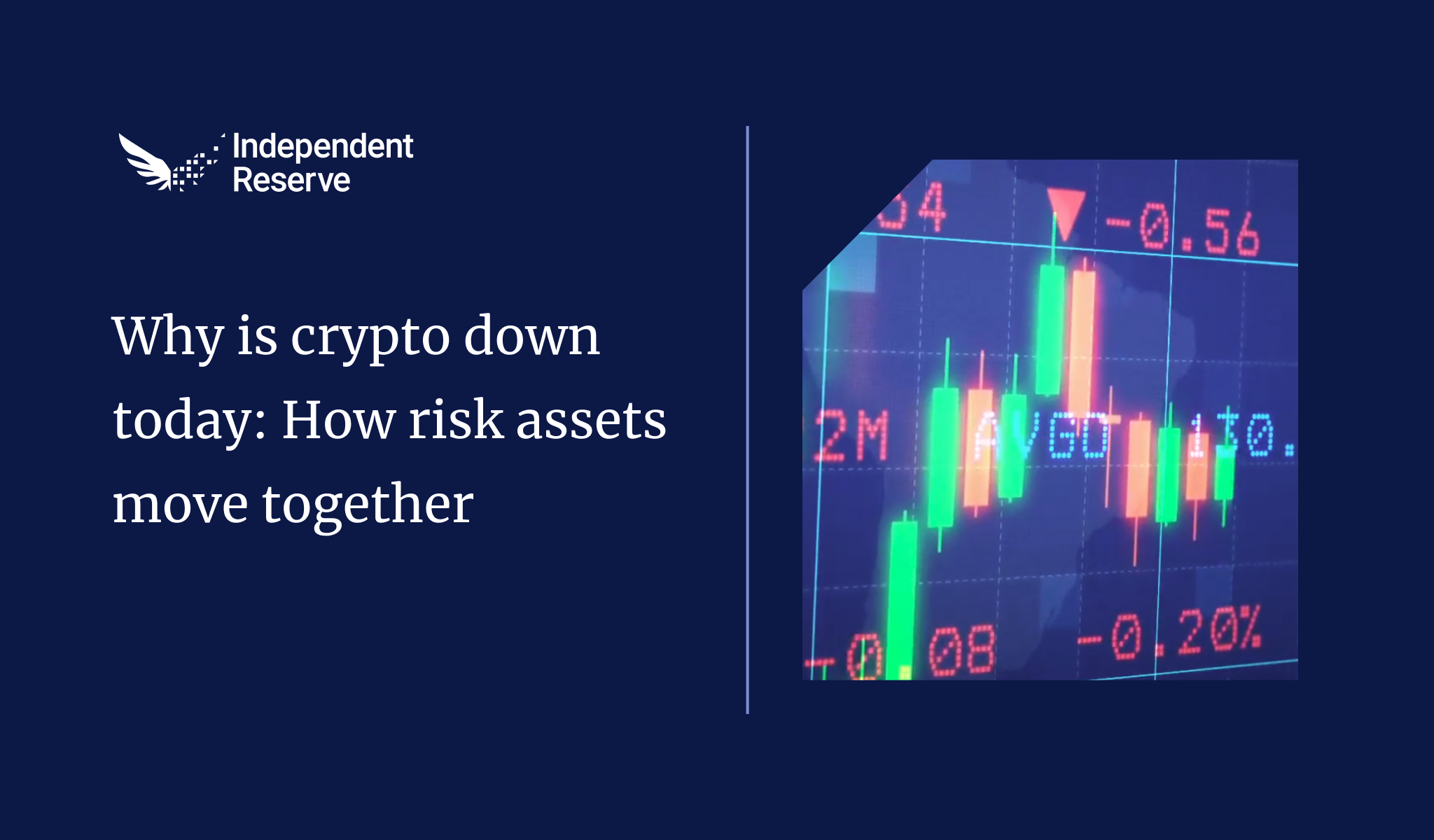In Markets
Crypto markets are seeing a price correction with many altcoins down by double digits this week. As usual, there are plenty of potential contributing factors, with inflation hitting a 40 year high in the US potentially forcing the Federal Reserve to accelerate its tapering plan and Chinese real estate giant Evergrande being declared in restricted default after failing to repay overseas bond holders. Bitcoin has also dipped below the 200-day moving average, which is never a good sign and finishes the week down 10% to trade around AU$65,500 (US$46,800). Ethereum lost 16% and is trading just above AU$5,300 (US$3,800). Cardano (-16%), XRP (-8%) and Dogecoin (-14%) all lost ground. The Crypto Fear and Greed Index is at 28, or ‘Fear’.
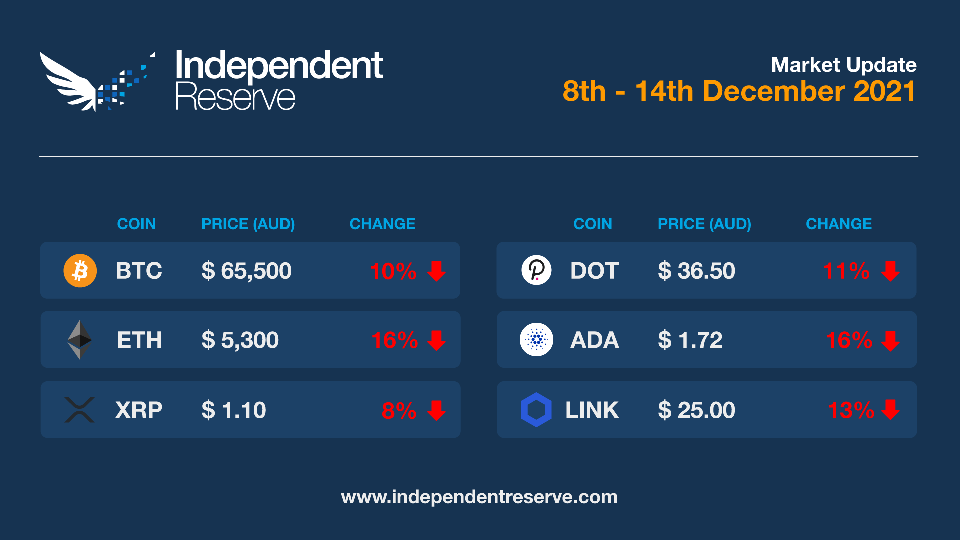
From the IR OTC Desk
This week sees the US FOMC meeting (Thursday) take centre stage. Following on from last week’s US CPI release of 6.8% – which was the fastest rate of price increases since 1982 – both the expected trajectory for interest rates as defined by the dot plot and the press conference following the release will be carefully followed. Of note will be whether the speed of QE tapering is adjusted, and the median expectation for rate hikes from the Committee for both 2022 and 2023. Previously, we have mentioned communication from Chair Powell retiring the word “transitory” when discussing inflation. This week’s communication will be the first official FOMC release following this change in stance.
The final Reserve Bank of Australia (RBA) meeting for the calendar year saw the Board retain the current policy setting. Within the detail of the release was confirmation that the Board will review the bond purchase program at the February meeting. Additionally, the Bank is now forecasting the economy to return to its pre-Delta growth path in the first half of 2022 (previously late 2022). Australian employment data (Thursday) will remain the critical data point for the week, following on from a soft October print. With the Board articulating the requirement for the labour market to be tight enough to generate wage growth, before any consideration can be given to interest rate policy, employment data will remain highly critical.
On the OTC desk, flows have been light, relative to historical volumes. In what appears to be the combination of seasonality and market patience associated with the US CPI print and this week’s FOMC meeting, price action has trended lower, leading the market to remain cautious. ETH/BTC recorded its highest level since February 2018 – reaching circa 0.0880 – before retracing back towards 0.0810. In layer 1’s, market retracements have continued in SOL, LUNA, AVAX, DOT. All eyes will be firmly focused on the US Fed for an indication of the market’s next direction.
For any trading needs, please don’t hesitate to get in touch.
In Headlines
Independent Reserve: Digital Currency Exchange of the Year!
Independent Reserve was a big winner at Blockchain Australia’s The Blockies awards, picking up Digital Currency Exchange of the Year (for the second time in a row) and Blockchain Organisation of the Year. Other winners included Mycelium, Entersoft, Chloe White, and Adriana Belotti.
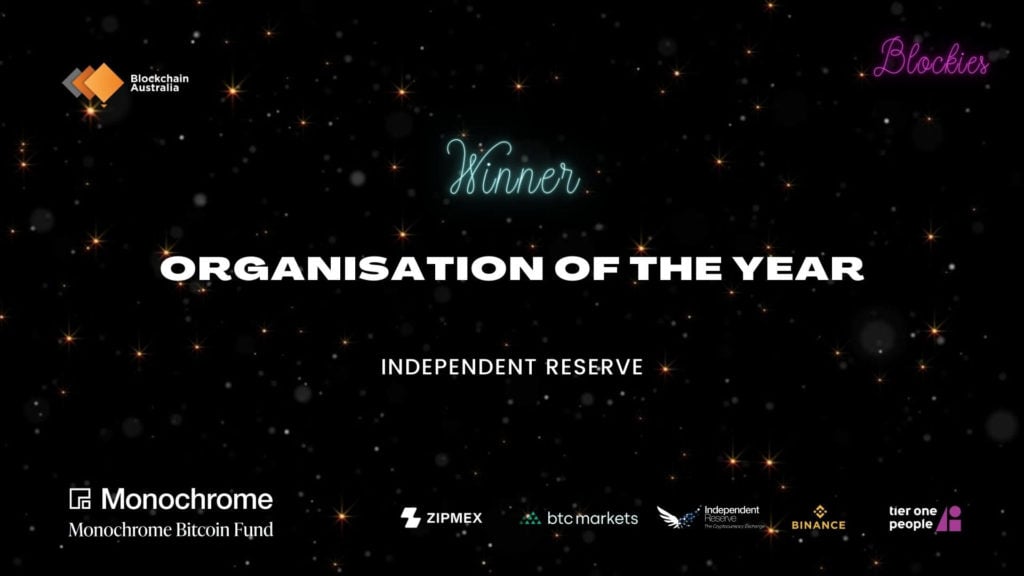
Crypto reforms coming
The Federal Government has endorsed six of the crypto reforms suggested by the recent Senate Committee report, including a licensing regime for crypto exchanges, laws to govern decentralised autonomous organisations (DAOs), and a common access regime for new payments platforms. It knocked back a 10% tax reduction for using renewable energy in Bitcoin mining, but is still investigating a proposal to clarify capital gains tax relating to crypto and another recommendation to “address bank due diligence of crypto providers”. Treasurer Josh Frydenberg said, “For consumers, these changes will establish a regulatory framework to underpin their growing use of crypto assets and clarify the treatment of new payment methods.” The powers that be are also favourably disposed towards a CBDC and the RBA’s Project Atom research reported this week there are numerous benefits to a wholesale CBDC.
Biden’s OCC nominee drops out
President Joe Biden’s controversial nominee to head the Office the Comptroller of the Controller has withdrawn her nomination. Saule Omarova had faced attacks from Republicans and some Democrats over her Russian background, university thesis on Karl Marx and her claimed anti-bank and anti-crypto stances. Biden said that, “Saule was subjected to inappropriate personal attacks that were far beyond the pale.”
Big guys tip 2022 correction
A survey of 500 institutional investors from 29 countries by Natixis Investment Managers found that more than 50% expect crypto markets to correct in 2022. In fact they’re tipping corrections across the board with 45% predicting one for interest-rate-sensitive bonds, stocks (41%) and technology (39%). “On the upside: “Four in ten consider crypto to be a legitimate investment option, and of the 28% who invest in crypto, 90% say they will maintain (62%) or increase (28%) their allocation.”
Ethereum gas fees fall
Ethereum’s gas fees have been falling for six weeks in a row now and are now 50% cheaper than the late October peak of 190 Gwei. In other ETH stats, addresses holding 0.1 ETH or below reached a record high of 19.95 million on December 4. Addresses with 0.1 ETH or more also climbed to a new all-time high of 6.37 million on December 12 according to Glassnode. Meanwhile the Bitcoin network hit a new milestone this week, and there is just 10% of Bitcoin, or 2,100,000 BTC, remaining to be mined. It’ll take another 119 years to do so however.
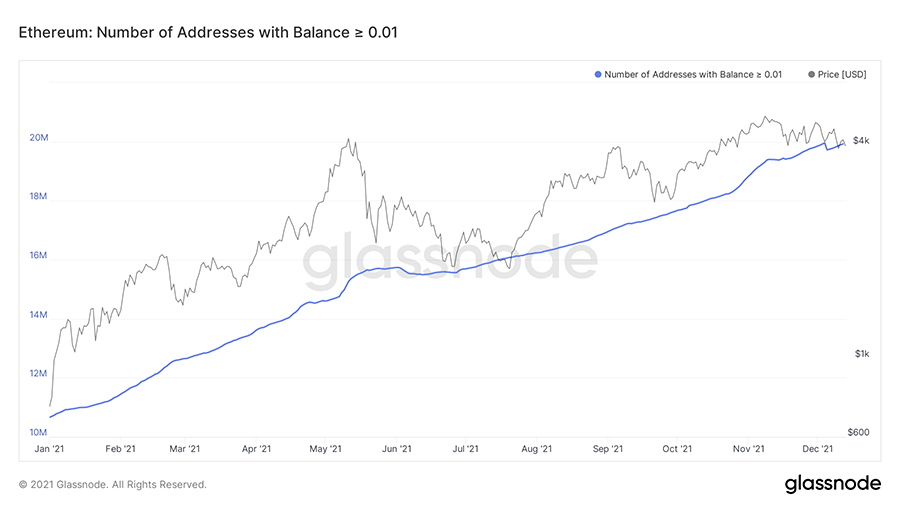
Ethereum addresses with balances less than or equal to 0.01. Source: Glassnode
Solana slows
The Solana network suffered a Distributed Denial of Service attack this week, slowing things down without entirely knocking the network offline. Back in September, it suffered a 17-hour outage from a similar attack. CIO of Cyber Capital Justin Bons blamed the network’s Proof of History mechanism which he says “sacrifices decentralization & security for speed.” “In SoL it is possible to predict & therefore attack the next block producers inline. For instance, attacking the next 100 validators inline instead of attacking the entire network. This attack also works regardless of scale, thereby severely reducing SOL security.” On the other hand, even a slow Solana network managed to process 1000 transactions per second which is an order of magnitude greater than many other blockchains.
Good news for bulls
The mood’s turning bearish, which is why it’s always good to hear another perspective from permabulls. A new Bloomberg Intelligence report says that Bitcoin is in a consolidating bull market and on its way to US$100,000 (AU$140,000). Mainstream adoption, ETFs, and declining returns in stocks and bonds may shine on Bitcoin and Ethereum in portfolios. “Bitcoin appears to be on a trajectory for $100,000. We see it as more of a question of time, notably due to the economic basics of increasing demand vs. decreasing supply,” the report said. That’s a price increase for ants though according to ARK Invest founder and CEO Cathie Wood who told CNBC this week: “We think the move by institutions into Bitcoin … could add $500,000 (AU$701K) to Bitcoin’s price.” She thinks institutions are turning to Bitcoin for diversification as it’s a non-correlated asset and that the half a million dollar price could play out if institutional investors allocate around 5% of their capital to BTC over time.
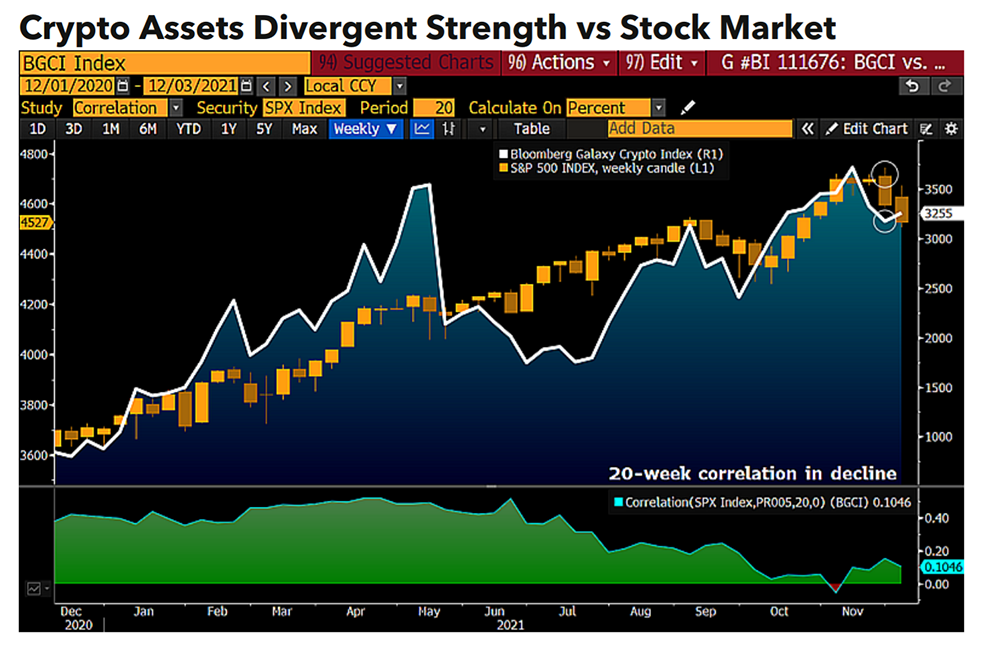
Source: Bloomberg
Microstrategy won’t stop
Microstrategy has once again added some more Bitcoin to their balance sheet, topping up a total of 1,434 BTC at an average price of US$57,477. Whilst not exactly picking the bottom, the company’s total Bitcoin holdings are now valued at more than US$5.7 billion, equating to more than US$2 billion in gains since its initial purchase in August 2020. The company has managed to make these large purchases using the company’s cash on hand in addition to sales of convertible senior notes in private offerings to institutional investors. Microstrategy remains the company with the most held Bitcoin.
Bitcoin: more decentralised than ever
The Bitcoin network has recovered more than twofold of its June global hash rate drop, which hit as low as 84 EH/s (exhashes per second). The hash rate recorded hitting 186 EH/s on Wednesday, according to YCharts, a significant metric in measuring the overall amount of computing and processing power contributed to the network via mining. The sharp drop at the start of June stemmed from the ban on crypto mining in China, which before then, accounted for the majority (70%) of the global hash rate. Over time, this has led to further decentralisation of the network, with fears relating to “China banning Bitcoin” being put to rest as global hash rate distribution picks up. Currently, the majority of the global hash rate belongs to the United States (42%), according to the University of Cambridge’s Bitcoin Electricity Consumption Index.
Until next week, happy trading!

